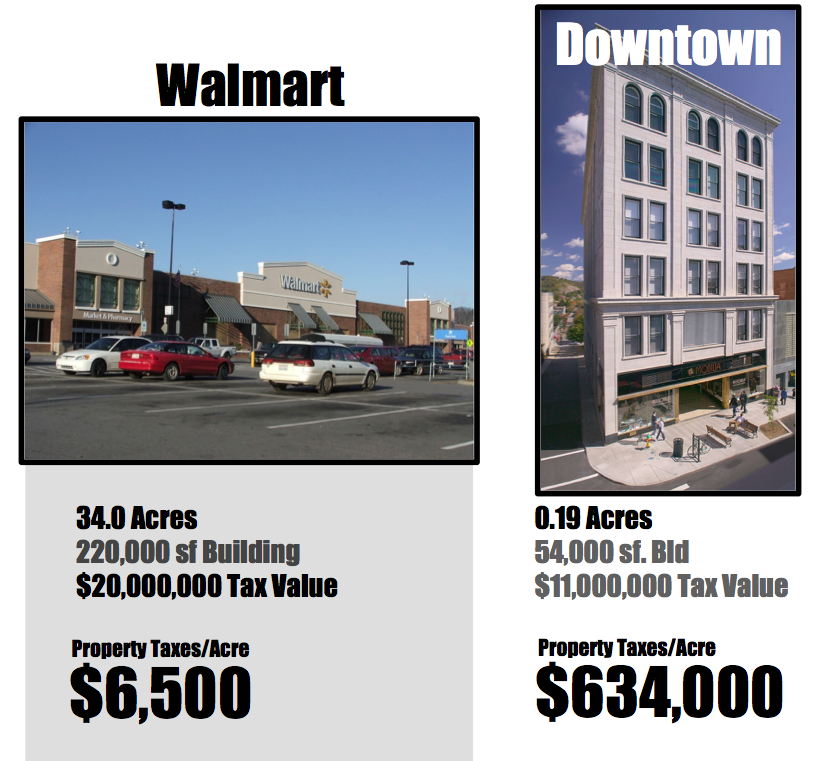Big box stores are costing our cities far more than we ever imagined.
A Walmart and surrounding parking lot near Asheville (Source: Google Maps)
Drive a little ways out from the center of any town and you’re likely to find several big box stores—Target, Home Depot, Piggly Wiggly, you name it. They’re everywhere. If you took a helicopter or a drone above these parts of town, you’d likely see a vast amount of land taken up with just a handful of stores and their accompanying parking lots. The houses and small businesses around them would be dwarfed in comparison. Not only do they use up a ton of land, but as a result, big box stores also demand miles of public infrastructure like pipes and roads to serve them.
But here’s the crazy part: Those enormous stores are paying a negligible amount in taxes. For their size, they are contributing hardly anything while meanwhile demanding new electric lines and frontage roads and signalized intersections (among other things). In most cases, their taxes are not nearly enough to pay for the maintenance of these basic services, let alone the many other functions of our local governments that we expect taxes to pay for, like schools and fire protection.
Here’s a textbook example of this, created by our friends at Urban3, a firm that analyzes the relationship between building design and tax production. The illustration below shows the tax value of a big box store near Asheville, North Carolina, compared with a modest downtown building . Pay special attention to the taxes per acre.
What we can plainly see is that the big box store pays a minuscule amount in taxes when compared with the downtown building, especially when we consider how much land it takes up and how many utilities it uses.
If we constructed just one more downtown building next door to the one above, the two structures would offer more tax revenue for our city than the entire Walmart currently provides — all while taking up a tiny fraction of the space that the Walmart uses (around 4/10 of an acre vs. 34 acres).
This is not important because we love multistory buildings or density. It doesn’t have anything to do with aesthetics. Rather, it's important because that simple six-story building uses just a few dozen yards of street and sidewalk and pipe while generating tons of revenue for the city. And the Walmart, as we’ve already explained, uses massive amounts of public infrastructure, all to service just one store.
What’s more, the Walmart also requires people to drive to access it—which means they each have to own a car and money for gas and insurance—whereas the downtown store could be accessed on foot by the thousands of people whose homes are within half a mile of it for free.
For the last seventy years, most cities, suburbs and towns have based their development—whether housing or retail or office—around cars. We’ve built extensive road networks and parking lots in front of every store and house. We’ve built it all brand new, beginning as soon as cars became available to regular consumers. It has its benefits of course, but it is also costing our communities far more than we could ever have imagined.
If we zoom out from this small example of the Walmart vs. the downtown store, we can see how these two types of buildings impact entire cities and regions.
The above illustration from Urban3 shows the tax value per acre of developments across the county in which Asheville exists. The high peaks of purple, red and orange are buildings that are worth anywhere from $6 to $20 million dollars per acre.
And all that vast green land around them? It’s worth less than $200,000 per acre. The concentrated segment of high-value buildings is downtown Asheville. Much of the surrounding area is Walmart-style development.
There’s nothing wrong with this type of development on its face. But when we see how much it is contributing in taxes in relation to how much space it's taking up and how much public infrastructure it's using, well, then there’s something wrong indeed.
In short, the revenue from downtown businesses and homes is subsidizing everything else.
As our communities have shifted focus from downtown to the car-oriented development on the edges, we have given up reliable sources of municipal revenue in exchange for big risks (remember how much space those stores take up) with little gains.
Here at Strong Towns, we’re advocating for a return to those traditional models of development. The ones that didn’t require a car to get everywhere, that were built in a manner which produced enough taxes to cover the public goods it utilized (plus the schools, firefighters, and other public features necessary to make a city function). We're advocating for cities built around people like you and me — not outside corporations.
If you'd like to learn more about this challenge and how to address it in your town, here's a deeper dive. And if you'd like to help us build stronger towns across America, join the movement.




Rachel Quednau serves as Director of Movement Building at Strong Towns. Trained in dialogue facilitation and mediation, she is devoted to building understanding across lines of difference. Rachel has served in several different positions with Strong Towns over the years, as well as worked for local and federal housing organizations. A native Minnesotan and honorary Wisconsinite, Rachel attend Whitman College for her undergraduate and received a Masters in Religion, Ethics, and Politics from Harvard Divinity School. She currently lives in Milwaukee, Wisconsin, with her husband and two young children. One of her favorite ways to get to know a new city is by going for a walk in it.